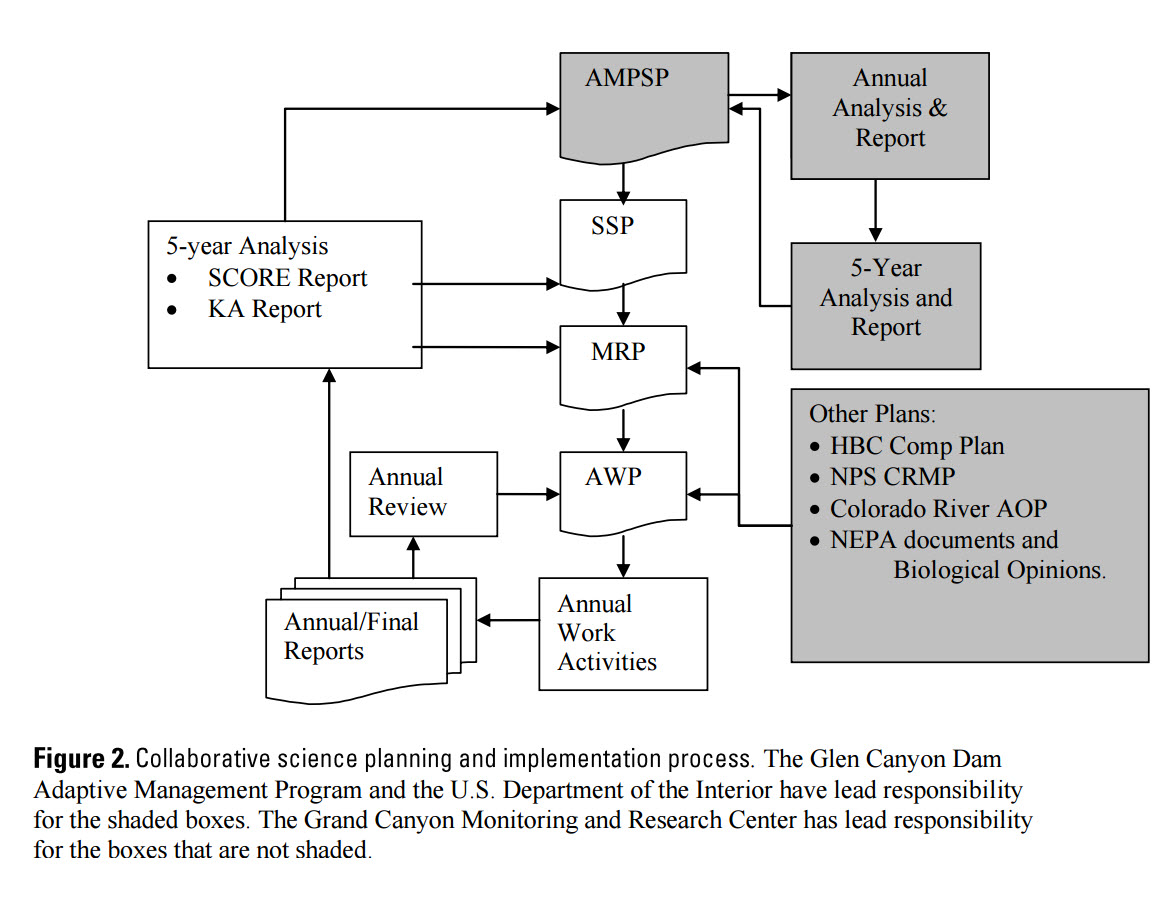Difference between revisions of "GCDAMP Planning"
Cellsworth (Talk | contribs) |
Cellsworth (Talk | contribs) |
||
| Line 70: | Line 70: | ||
provide general guidance for planning, monitoring, and research efforts. | provide general guidance for planning, monitoring, and research efforts. | ||
| − | The ''' | + | The '''Goals of the GCDAMP''' are: |
# Protect or improve the aquatic food base so that it will support viable populations of desired species at higher trophic levels | # Protect or improve the aquatic food base so that it will support viable populations of desired species at higher trophic levels | ||
| Line 86: | Line 86: | ||
| − | In August 2004, the AMWG reviewed these goals and identified ''' | + | In August 2004, the AMWG reviewed these goals and identified '''Five Priority Questions''' to help guide the GCDAMP science program: |
# Why are the humpback chub not thriving, and what can we do about it? How many humpback chub are there and how are they doing? | # Why are the humpback chub not thriving, and what can we do about it? How many humpback chub are there and how are they doing? | ||
| Line 111: | Line 111: | ||
*[[Portal:Desired Future Conditions -DFCs| 2012 Desired Future Conditions]] | *[[Portal:Desired Future Conditions -DFCs| 2012 Desired Future Conditions]] | ||
*[[PEP reviews]] | *[[PEP reviews]] | ||
| − | |||
| − | |||
*[[Long-term Experimental and Management Plan (LTEMP)]] | *[[Long-term Experimental and Management Plan (LTEMP)]] | ||
Revision as of 16:19, 21 July 2016
|
|
The GCDAMP is based on an adaptive environmental assessment and management (AEAM) approach to natural resources management (Holling, 1978; Walters, 1986), now commonly called ―adaptive management. The approach assumes that managed natural resources will always change, that scientific understanding of ecosystems is constantly improving, and that natural resource managers need the best available information to make decisions. AEAM unites the strengths of different scientific disciplines to meet the information needs of resource managers. It encourages scientists and managers to work collaboratively to use scientific information in the management process. AEAM consists of two parts—adaptive assessment and adaptive management. Assessment investigates how ecological systems work and evaluates management alternatives to achieve goals. Management involves learning by doing and testing, which may include monitoring system responses to natural changes (passive adaptive management) or deliberate manipulation of key processes (active adaptive management). Adaptive management acknowledges that policies must satisfy social objectives, but policies also need to adapt to both changes in understanding and changes in managed systems. Managers using an AEAM approach learn how a natural system works and how their actions affect the system; this knowledge helps them to perform better in complex and uncertain environments. |
| GCDAMP Strategic Plan The GCDAMP Strategic Plan (AMPSP) is a long-term plan drafted in August 2001 by GCDAMP and GCMRC participants that identifies the AMWG’s vision, mission, principles, goals, management objectives, information needs, and management actions. |
Strategic Science Plan The GCMRC Strategic Science Plan (SSP) identifies general strategies for the next 5 years to provide science information responsive to the goals, management objectives, and priority questions as described in the AMPSP and other planning direction approved by the AMWG. |
Core Monitoring Plan The GCMRC Core Monitoring Plan (CMP) describes the consistent, long-term, repeated measurements using scientifically accepted protocols to measure status and trends of key resources to answer specific questions. Core monitoring is implemented on a fixed schedule regardless of budget or other circumstances (for example, water year, experimental flows, temperature control, stocking strategy, nonnative control, etc.) affecting target resources. |
Monitoring and Research Plan The GCMRC Monitoring and Research Plan (MRP) specifies (1) core monitoring activities, (2) research and development activities, and (3) long-term experimental activities consistent with the strategies and priorities established in this SSP to be conducted over the next 5 years to address some of the strategic science questions associated with AMWG priority questions. |
Triennial Work Plan (TWP) The GCMRC Triennial Work Plan (TWP) identifies the scope, objectives, and budget for monitoring and research activities planned for a 3-year period. When completed, the triennial work plan will be consistent with the MRP. |
|---|
|
|
